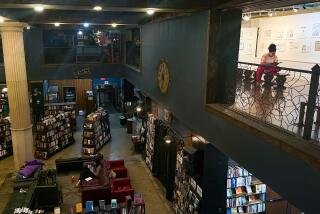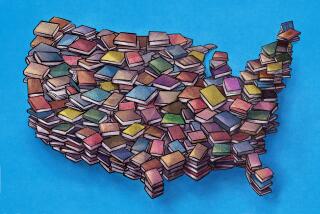A Tour of âHub of Literatureâ in Young America
BOSTON â The Boston State House may not be the âhub of the Solar System,â as Oliver Wendell Holmesâ famous quotation claims, but in the 1800s, Boston certainly was the cultural capital of the United States.
The entire literary heritage of the young country seems crowded into the streets of Boston--and since the city was small then, the homes and haunts of many of the giants of the early Boston literary scene can be visited in a dayâs walk.
Start at School and Washington streets, at the Globe Corner Bookstore, originally owned by the publishers Ticknor and Fields. Established in 1828 (in a 1711 building), the store quickly became a landmark. As noted by Van Wyck Brooks in âThe Flowering of New England,â âThere was always some author in Fieldsâs cozy nook, Longfellow, Mrs. Stowe or Emerson, sitting on the window-seat in a litter of books and papers. The shop was crowded with visitors, poets, historians.â It still is, and it stocks a wide selection of books by the authors mentioned here.
From the bookstore, follow School to Tremont Street, where youâll find the Omni Parker House Hotel, former home of the Saturday Club, named for its meetings of literary types on the last Saturday of each month.
Founded in 1855 as the Literary Club and the Magazine Club, the group was started by Horatio Woodman, a Boston publisherâs agent. Members were the noted men of letters of the day: the scientist Louis Agassiz; Richard Henry Dana Jr., author of âTwo Years Before the Mastâ; Henry Wadsworth Longfellow; John Greenleaf Whittier, and, most memorably, James Russell Lowell and Oliver Wendell Holmes.
Guests through the years included Nathaniel Hawthorne, Henry David Thoreau, Henry James, Ralph Waldo Emerson (who became a regular) and Charles Dickens, who served the club his special punch from England.
The Magazine Club achieved its purpose in 1857 with the formation of the Atlantic Monthly, named by Holmes and edited first by Lowell. Afterwards edited by J.T. Fields (who with W.D. Ticknor owned the famous bookshop around the corner), the Atlantic has since published almost every American writer of note.
The two clubs then merged to become the Saturday Club, at whose meetings little was accomplished save eating, drinking and the trading of bons mots; meetings began at 3 oâclock and ended, seven courses later, about 9.
The buildingâs literary associations fell off around the turn of the century, but other writers were associated with the hotel: Malcolm X waited tables at the Parker House and Ho Chi Minh, who had come to Boston about 1912 as a seaman, is said to have chopped vegetables in its kitchen.
From Parker House, cross Tremont where School becomes Beacon Street. At 10 1/2 Beacon is the Boston Athenaeum, perhaps the most charming literary building in the city. Built in 1846, the sooty stone facade belies the splendor within.
In the two-story main reading room, white arches stretch in either direction; walk to the left, into the periodical room, where in one of the bays overlooking the Granary Burial Ground you can read a magazine or newspaper from any place in New England. A grandfather clock near the front of the room makes the only sound youâll hear.
Busts atop the two-story book stacks peer sternly down, and a spiral staircase in the corner leads up to the green-railed balcony. On the second floor is a meeting room full of Doric columns, arches, and more busts. Of course, books are everywhere, the rare alongside the merely scholarly. For literary types, here is heaven on earth.
From the Athenaeum continue to the corner of Park and Beacon, across from the State House, to an antiques shop with black metal bay windows. This was once the most famous literary house in Boston, belonging to George Ticknor (1791-1871), cousin of W.D. Ticknor.
Ticknor was known for being one of the first Americans to take a âgrand tourâ and be received by the literary greats of Europe. Back in Boston, Ticknor became a Harvard professor, and his house became a center of learning with, according to Brooks, âthe amplest private library in Boston.â
Continue down Beacon to No. 50, where a stone tablet notes that you are near the spot where William Blaxton, Bostonâs first settler in 1625, chose to live a simple life--and, building Boston tradition, brought along his books.
Stop at 55 Beacon, a red-brick building with an iron balcony running the length of its bow-windowed front. Here lived William Hickling Prescott (1796-1859), who spent his youth among books donated by John Quincy Adams, which became the basis for the Athenaeum.
Further educated at Harvard, he wrote occasionally for The North American Review, which grew in 1815 from the Monthly Anthology, the first American literary publication. With many of the writers from the Review, he kept a literary club predating the Saturday Club, and he became a close friend to George Ticknor.
From Prescottâs house, turn right onto Charles Street into Beacon Hill and proceed to Mt. Vernon Street; climb Mt. Vernon until you reach Louisburg Square.
At No. 4 lived William Dean Howells, longtime editor of the Atlantic, friend to Twain and one of the preeminent writers of his generation. Born in Ohio, Howells visited Boston in 1860 to dine with Lowell, J. T. Fields and Holmes at the Parker House. Apparently he impressed the company, for in 1866 he was invited back to be co-editor of the Atlantic. In 1871, he became editor and remained in the job for 10 years.
At No. 5 Louisburg Square lived John Palfrey (1796-1881), onetime editor of the North American Review and writer of one of the first thorough histories of the New World (âHistory of New England, 1858-1890â).
No. 10 was the last Boston home of Louisa May Alcott, author of âLittle Women.â
On your way out of Beacon Hill, stop in front of 57 Mt. Vernon, where Daniel Webster, who delivered the Bunker Hill Addresses of 1825 and 1843 and whose legendary argumentative prowess inspired Benetâs story âThe Devil and Daniel Webster,â lived from 1817 to 1819. Stop also at 32 Mt. Vernon, home of Julia Ward Howe, who wrote the lyrics for âThe Battle Hymn of the Republic.â
Take a right at Joy Street into the Common. As you walk across, you will be following the steps of Holmes, whose Long Path was made famous in his series of magazine essays, âThe Autocrat of the Breakfast Table.â Among those essays he also made the comment that gave Boston its nickname âthe Hub.â
Stop for refreshment at the cafe Cornucopia, 15 West St. From 1840 to 1854, the cafe was the home of Elizabeth Palmer Peabody, reformer and woman of letters. In her house, she and Emerson published The Dial, the Transcendentalist quarterly, from 1840 to 1844.
Margaret Fuller, The Dialâs first editor, gave her classic âConversationsâ there from 1839 to 1844. From these lectures she developed a book, âWoman in the Nineteenth Century,â which the Oxford Companion to American Literature calls the first mature consideration of feminism by an American.
Now continue by heading back across the Common to the Public Garden, to the statue of the mother duck and ducklings from Robert McCloskeyâs famous childrenâs book, âMake Way for Ducklings.â More literary books may have emerged from Boston, but certainly no other book has charmed so many.
To conclude the tour, take the âTâ (Bostonâs subway-surface line) to Harvard Square. Start at 105 Brattle St., the house given to Henry Wadsworth Longfellow in 1843 by the father of his bride, Fanny Appleton.
There, Longfellowâs career and family burgeoned. When in 1854 he stopped teaching at Harvard in order to devote himself to his writing, he built a garden in the shape of a lyre and there composed verse. Publishing such poems as âThe Village Blacksmith,â âThe Bridgeâ and âThe Courtship of Miles Standish,â he grew increasingly famous; Prescott and Ticknor were frequent guests.
Longfellow is the only American poet to have been honored with a bust in Londonâs Westminster Abbey, but his house is his truest memorial. Besides the poetâs books and furnishings, the house includes a chair made from the wood of the âspreading Chestnut tree.â
At 56 Brattle St. is the Blacksmith House Cafe, where that tree once stood.
Continue down Brattle. On the north side of the street, between Kennedy Road and Channing Street, identified by a sign, is the home of John Bartlett (1820-1905).
The owner of the University Bookstore in Harvard Square, Bartlett kept a book of familiar sayings that grew so prodigious, he became the arbiter of the correct wording of familiar quotations. So prodigious, in fact, that we still refer to Bartlettâs Familiar Quotations.
Continue down Brattle to Elmwood Avenue and head left. At the corner of Elmwood and Mt. Auburn stands Elmwood, built in 1767 and the home of James Russell Lowell (1819-1891).
Editor of the Atlantic and the North American Review and professor of languages at Harvard (he succeeded Longfellow), Lowell epitomized the Cambridge intellectual life. Despite his travels around the world, Lowell always returned, in his mind and his work, to Cambridge. The title of his collection, âMy Study Windows,â indicates his outlook.
To finish the tour, turn right on Mt. Auburn and walk a block to the north entrance of Mt. Auburn Cemetery. The oldest horticultural cemetery in the country (founded in 1831), Mt. Auburn is known as the Westminster Abbey of America--here lie the graves of Longfellow, Holmes, Bartlett, Lowell, Edward Everett, J.T. Fields, Julia Ward Howe and other luminaries.
Wherever you walk, though, the cemetery is the perfect place to finish literary tour by considering the transitory lives of even the famous writers interred there. You may even, on one of the cemeteryâs benches, write a few lines of your own.
GUIDEBOOK
Literary
Boston
Globe Corner Bookstore, 3 School St., telephone (617) 523-6658.
Omni Parker House Hotel, 60 School St., (617) 227-8600.
Boston Athenaeum, 10 1/2 Beacon St., (617) 227-0270. Open 8:30 a.m. to 5:30 p.m. weekdays, 9 a.m. to 4 p.m. Saturday. Admission is free.
Cafe Cornucopia, 15 West St., (617) 338-4600.
Longfellow House, 105 Brattle St., (617) 876-4491. Open daily. Admission: $2 for adults, children and seniors free.
Blacksmith House Cafe, 56 Brattle St., (617) 547-6789.
Mt. Auburn Cemetery, Elmwood Avenue and Mt. Auburn, (617) 547-7105.
More to Read
Sign up for our Book Club newsletter
Get the latest news, events and more from the Los Angeles Times Book Club, and help us get L.A. reading and talking.
You may occasionally receive promotional content from the Los Angeles Times.








